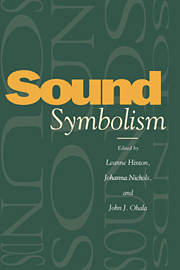Book contents
- Frontmatter
- Contents
- List of contributors
- 1 Introduction: Sound-symbolic processes
- PART I Native American languages north of Mexico
- PART II Native languages of Latin America
- PART III Asia
- PART IV Australia and Africa
- PART V Europe
- PART VI English
- PART VII The biological bases of sound symbolism
- 21 Some observations on the function of sound in clinical work
- 22 The frequency code underlies the sound-symbolic use of voice pitch
- 23 Sound symbolism and its role in non-human vertebrate communication
- Index
22 - The frequency code underlies the sound-symbolic use of voice pitch
Published online by Cambridge University Press: 04 August 2010
- Frontmatter
- Contents
- List of contributors
- 1 Introduction: Sound-symbolic processes
- PART I Native American languages north of Mexico
- PART II Native languages of Latin America
- PART III Asia
- PART IV Australia and Africa
- PART V Europe
- PART VI English
- PART VII The biological bases of sound symbolism
- 21 Some observations on the function of sound in clinical work
- 22 The frequency code underlies the sound-symbolic use of voice pitch
- 23 Sound symbolism and its role in non-human vertebrate communication
- Index
Summary
Introduction
In this paper I propose that certain global uses of intonation across languages exhibit sound symbolism, i.e. they show a motivated link between the shape of an intonation pattern and its meaning or function. This is not a new claim (Hermann 1942) and, in general, there is a very large literature claiming the existence of sound symbolism in other, usually segmental or lexical, domains. But there are several good reasons for being sceptical of such claims, including those I make here.
First, it runs counter to the dominant Saussurian dictum that “the sign is arbitrary,” i.e. that the link between sound and meaning is conventional, not natural. This has been a productive working principle and we should not weaken its application to language without good reason. Actually, some amount of acoustic iconism or onomatopoeia in language has always been acknowledged, but it was usually held to represent a negligible fraction of the entire language.
Second, there has typically been no convincing theory offered as to why sound symbolism should exist in languages, nor for the most part has anyone offered a motivation for linkage between particular phonetic features and semantic features. Notable exceptions to this can be found in the work of Paget (1930) and Fonagy (1983), among others, although none of these can be said to have had widespread influence.
- Type
- Chapter
- Information
- Sound Symbolism , pp. 325 - 347Publisher: Cambridge University PressPrint publication year: 1995
- 55
- Cited by

